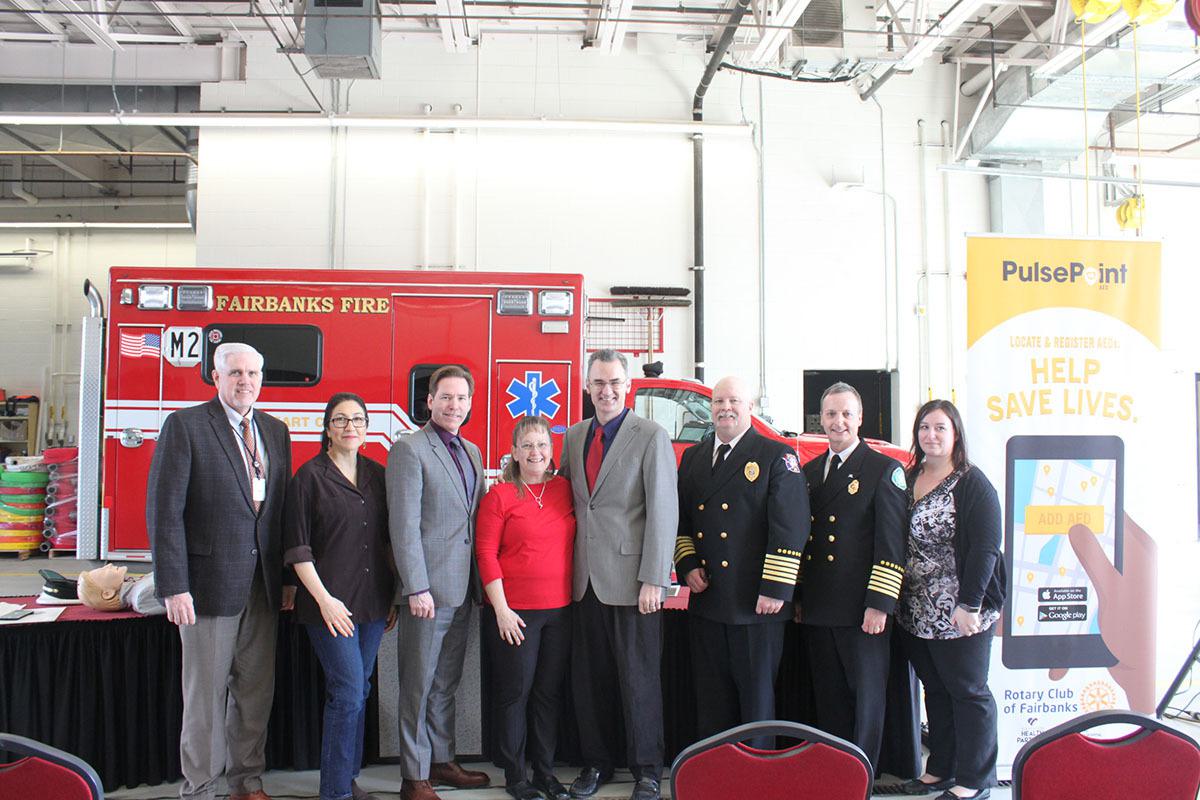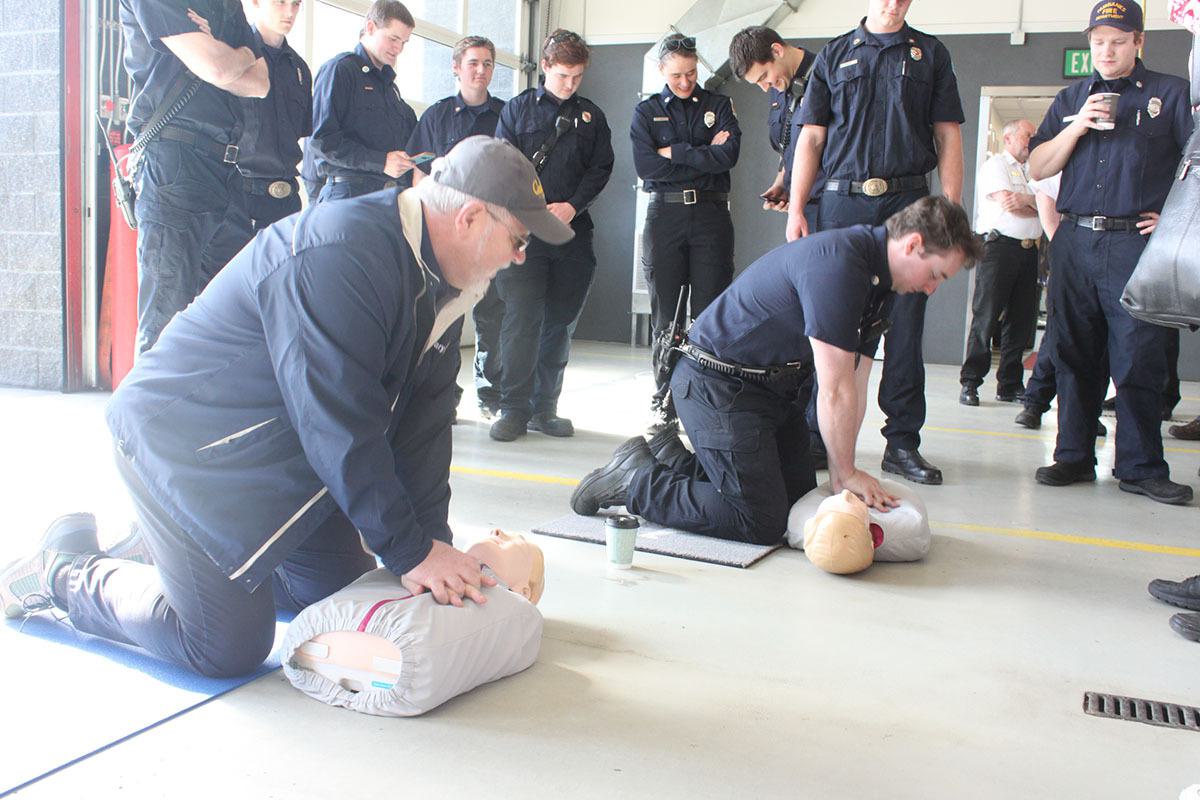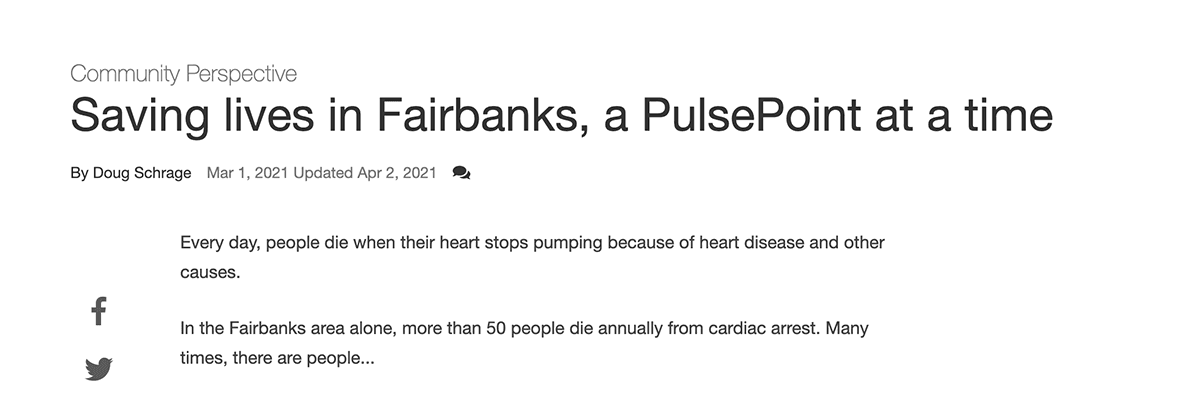July 27, 2021 | by Admin
Utilizing a Full-Suite PulsePoint Integration to Address Out-of-Hospital Sudden Cardiac Arrests in Alaska’s Fairbanks North Star Borough
CASE STUDY / APRIL 2021
Summary
Alaska’s Fairbanks North Star Borough sought to address the rural community challenges of low bystander engagement and slower response times in out-of-hospital sudden cardiac arrest response. As part of a comprehensive strategy that included participation in the C.A.R.E.S. Registry and Resuscitation Academy, bystander CPR training, CPR and AED awareness programs, and strategic AED placement, Fairbanks launched PulsePoint May 2019.
Within the first two years of implementing PulsePoint Respond, PulsePoint Verified Responder and PulsePoint AED, the borough of Fairbanks greatly exceeded their participation and performance goals, ultimately contributing to higher cardiac arrest survival rates.
Context
Fairbanks North Star Borough is Alaska’s third-largest municipality, with a population of approximately 100,000 citizens; it is also home to the University of Alaska Fairbanks. The class-two borough (meaning it is subject to less government control, relying primarily on voter approval) has 11 fire departments and 321 firefighters, most of whom are volunteers.
This subarctic borough is surrounded by hundreds of miles of sparsely populated areas. Given its geographic isolation and harsh climate, the city has been largely self-reliant and dependent on a high level of community engagement.
Challenges
The borough’s 11 fire departments shared specific challenges: lower bystander engagement in administering CPR, longer travel and response times in mostly rural communities, limited resources and inconsistent training of staff. Despite these common issues, each department largely operated independently, with no automatic aid across jurisdictional boundaries except for water tenders (transporting water to a fire). They also hadn’t worked to market or promote educational opportunities with cohesive messaging across departments, so each fire department handled CPR and AED education separately.
The borough had not established a community-wide AED registry preventing them from tracking the number or whereabouts of area AEDs or determining if they were in working order. Without a dynamic AED registry they also couldn’t determine where there were “holes” in their AED coverage throughout the community.
Solutions
Supported by the Interior Fire Chiefs, University of Alaska Fairbanks Fire Chief Douglas R. Schrage spearheaded the borough’s efforts to address cardiac arrest response times and survival rates.
Chief Schrage first partnered with the Resuscitation Academy, which works with emergency medical service (EMS) leaders to help communities worldwide strengthen their cardiac arrest survival rates. Through the partnership, he and his colleagues developed a strategy that could be implemented in Fairbanks to teach best practices in sudden cardiac arrest (SCA) response. Chief Schrage also joined Cardiac Arrest Registry to Enhance Survival (CARES), one of the world’s largest EMS registries, to help Fairbanks to measure their SCA survival rates and ultimately improve care.
Once the borough had a strong understanding of best practices and how their outcomes compared nationally, the Chiefs felt strongly that they needed a solution to address low bystander engagement and longer response times.
The decision was made to integrate a full-suite PulsePoint solution with the Fairbanks Emergency Communication Center (FECC), the single Public Safety Answering Point (PSAP) overseeing calls for all 11 fire/EMS departments in the borough. The implementation, from project kick-off to soft launch, took 36 days. The average implementation takes roughly 150 days. The integration included:
- PulsePoint Respond is a 911-connected mobile app that alerts CPR-trained citizens when someone nearby is experiencing an SCA. When a 911 call-taker determines CPR may be needed, an alert is immediately sent to nearby app subscribers along with the dispatch of emergency responders. PulsePoint Respond alerts community responders only if the cardiac emergency occurs in a public location.
To increase community participation, PulsePoint Respond also informs subscribers of emergency activity in real-time, alerting residents to traffic collisions, wildland fires and other emergencies. Subscribers can listen to live dispatch audio (if offered by the agency) for updates being sent to the responding crews as they make their way to the citizen in need of assistance. - PulsePoint Verified Responder Pro is the professional version of PulsePoint Respond for public safety employees. Professional firefighters, invited by their agency to use the app while off-duty, are notified of all nearby cardiac arrest events, including those in private and residential locations. They also receive advanced functionality, including access to all calls within the jurisdiction (as opposed to the filtered list seen by PulsePoint Respond subscribers), complete address and routing for all incidents, more detailed incident descriptions and additional notification options.
- PulsePoint AED is a tool to help build a community’s AED registry by pinpointing the location of AEDs throughout the community. This allows the AEDs to be accessible during a cardiac emergency to both emergency dispatchers and emergency responders, including nearby individuals trained in CPR (who are notified through PulsePoint Respond). PulsePoint AED also provides agencies with the ability to manage and display co-located resources (e.g., bleeding control kits, naloxone and epinephrine) and consumable information (e.g., battery and pad expirations).
For more information on PulsePoint Respond, Verified Responder Pro and PulsePoint AED, view the Fact Sheet.
Chief Schrage first learned of PulsePoint through his work with the Western Fire Chiefs Association (WFCA) and through collaborations with the Resuscitation Academy and CARES. Given the civic-minded nature of the borough, Schrage believed PulsePoint Respond could tap into a willing pool of potential citizen bystanders. There was some initial reluctance from borough chiefs who were unfamiliar with PulsePoint, apprehensive about the visibility of fire department activities to the public due to concerns of citizen involvement in 911 calls of a dangerous nature, or expressed concerns about cost.
Schrage, along with 2019 Interior Fire Chiefs Association president Geoff Coon, helped to educate the area chiefs on the benefits of PulsePoint and encouraged them to see the public’s access to a filtered list of dispatch calls as a positive way to engage the community and showcase the work of the fire department. And because the incident list is filtered, calls of a dangerous nature are not included in the public feed.
Schrage also knew, from working with the PulsePoint implementation team and discussing best practices with other PulsePoint-connected agencies, that community funds, local nonprofits or hospital systems often provided funding for PulsePoint. In fact, the Rotary Club of Fairbanks opted to pay the initial integration fee ($10,000) and first-year licensing costs ($8,000 annually). In its second year, Foundation Health Partners, the local hospital foundation, paid the annual licensing fee for PulsePoint Respond. The borough chiefs also saw the benefit of using off-duty personnel for faster residential response and each chief pulled from their department’s budgets (as part of the larger Fire Chiefs Association) to cover the added Verified Responder Pro costs ($2,500 annually). Schrage believes PulsePoint Verified Responder was such an important and integral part of the implementation he actually waited until the professional version was available (it launched in 2019) before moving forward.
PulsePoint is integrated directly into the Fairbanks Emergency Communication Center (FECC), the borough’s public safety communications center. The city connected their IT contractor with the PulsePoint implementation team to integrate PulsePoint directly with their computer-aided dispatch (CAD) in what Chief Schrage described as a “trouble-free and seamless integration.” Fairbanks opted for a response radius of a quarter-mile (standard) in the city center and one mile for more rural communities within their jurisdiction.
PulsePoint Respond launched in Fairbanks publicly in May 2019 with a press conference that was attended by all 11 participating chiefs and year-one sponsor Rotary Club, with several newspaper, radio and television news pieces resulting. At launch they offered free CPR instruction to attendees.


The fire departments printed and distributed PulsePoint-provided, localized marketing materials at all community events, including health fairs and Heart Month events. They positioned pop-up banners and posters at CPR-training events and partnered with their local American Red Cross and American Heart Association affiliates to disseminate information.
Links to a sampling of launch media coverage.
https://www.fairbanksalaska.us/fecc/page/pulse-point-now-fairbanks
https://www.webcenterfairbanks.com/content/news/A-New-App-that-could-save-lives-is-now-available-in-Fairbanks-509736621.html
http://www.newsminer.com/news/local_news/new-app-sends-alerts-when-cpr-is-needed/article_6ff44210-72fa-11e9-9da4-fb6d91ee10a1.html
The chiefs also understood that the adoption of PulsePoint was dependent on educating the community on the need for more public engagement in SCA response and providing opportunities for CPR and AED education. To increase engagement in year two (which experienced a lull during the COVID-19 pandemic), Schrage penned an article in the local paper encouraging participation.

The chiefs focused on internal messaging and an open dialogue with department staff to recruit for the voluntary Verified Responder Pro program. Although many of the firefighters lived outside of the city center, they understood the value of responding to their neighbors during a time-sensitive emergency while off-duty.
Chief Schrage reviewed best practices from other fire departments in North America to see how they handled off-duty pay, worker’s compensation and benefits as part of the PulsePoint Verified Responder Pro program.
Outcomes
The PulsePoint implementation was seen by area Chiefs as an “unifying force” for the 11 departments. Despite being under a single PSAP, the departments had historically worked independently of one another. However, working on the PulsePoint program integration forced better communication, cobranded marketing around PulsePoint, CPR education and AED use, and the addition of automatic aid, allowing for better response times and improved outcomes.
- Fairbanks has 4020+ PulsePoint Respond subscribers (3.38% of population). Of those, 1,801 (1.62% of population) have opted in for CPR alerts.
- The annual goal for PulsePoint subscribers per community is one percent of the population added annually. Currently, Fairbanks is at 169% of their goal.
- These subscribers have helped to increase bystander CPR rates to 63.3% (22% higher than the national average).
- Fairbanks has recruited 208 firefighters to participate in PulsePoint Verified Responder Pro, out of 321 total firefighters (65%) across the 11 departments.
- When a professional verified responder chooses to respond to a cardiac arrest activation while off-duty, he/she is invited to the monthly chiefs’ meeting to share their experience, providing the chiefs a first-hand account of the call and the professional verified responder access to management, which has bolstered participation in the program.
- Chief Schrage believes that PulsePoint aligns well with the fire department’s mission and can increase members’ sense of commitment to community service, both on- and off-duty.
- Fairbanks has also provided Verified Responder status to hospital providers, tribal health providers with medical training and retired firefighters, which has added 13 additional verified responders to their network (and several other physician groups are looking to be added). These individuals are activated on residential cardiac arrest alerts, but do not have access to the full incident list, which is only granted to those with Verified Responder Pro.
- Since Fairbanks’ launch, PulsePoint has processed 35 public SCA activations and activated on 23 of those (meaning a PulsePoint responder was within the response radius and responded).
- PulsePoint has processed 112 private SCAs and activated on 76 of those.
- Fairbanks sends 6.8 PulsePoint responders, on average, for each public activation. (The national average of PulsePoint responders per incident is three.)
- Fairbanks sends 5.8 PulsePoint responders, on average, for each private activation.
- The borough has registered 203 AEDs in the PulsePoint AED registry (double the borough’s two-year goal).
- PulsePoint also provided an impetus for the 11 fire departments within the borough to collaborate in solving shared issues, which aided the implementation of cross-department automatic aid (i.e., assistance dispatched automatically by contractual agreement between two communities or fire districts).
Download a PDF version of this case study.
Filed Under: Case Study, Highlights | Tagged With: Fairbanks, North Star Borough, Alaska, Rural, AED Registry, AED Management, AED Program, AED Registration, AED, Bystander Engagement, CARES, CARES Registry, Sudden Cardiac Arrest, cardiac arrest, Response Time, Resuscitation Academy, CPR, CPR Training, AED Awareness, Strategic AED Placement, Verified Responder, Cardiac Arrest Survival Rate, University of Alaska Fairbanks, Douglas Schrage, EMS Leadership, Case Study, Best Practice, Cardiac Arrest Registry to Enhance Survival, Fairbanks Emergency Communication Center, FECC, PSAP AED Registry, PSAP, PulsePoint Respond, Verified Responder Pro, Bleeding Control Kit, Naloxone, Epinephrine, PulsePoint AED, AED Consumable, Western Fire Chiefs Association, WFCA, Interior Fire Chiefs Association, Geoff Coon, Rotary Club of Fairbanks, Foundation Health Partners, CAD, American Red Cross, American Heart Association
